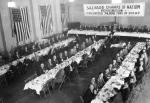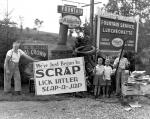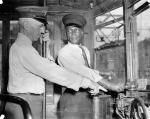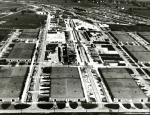Overview: The Arsenal of America: Pennsylvania During the Second World War
December 7, 1941: Franklin Delano Roosevelt said it was a day that would live in infamy. Americans alive at that moment can still, more than a half century later, recall vividly where they were when they heard the news that Japanese aircraft had struck the United States Pacific Fleet's base at Pearl Harbor, Hawaii. The war that many feared would eventually come to America had now arrived with startling suddenness.
Today, many Americans think of World War II as "the last good war," and indeed, the nation was united on a scale never seen before or since. There was no ambiguity about who the enemy was. Adolf Hitler and Nazi Germany had started the European problems in the 1930s by rearming and moving into neighboring countries.
The opening of formal war in 1939 started when the Nazi war machine attacked Poland. Then, in 1940, the German blitzkrieg rolled through France and forced British troops back to their home island. In North Africa, German and Italian forces threatened Egypt and Britain's lifeline through the Suez Canal. German U-Boats began sinking neutral merchant ships bound for England. In June 1941, the Nazis attacked the Soviet Union, opening a second, "eastern front."
In the Pacific, a militaristic Japan moved into China in the 1930s, then began eyeing the Asiatic possessions of European countries caught in the Nazi surge. But island Japan needed raw materials unavailable at home to fuel its war machine. To curtail Japanese aggression, President Roosevelt prohibited the sale of oil, scrap metal, and other materials to Japan.
Worried over this turn of events, Japan decided on a bold gamble; the plan was for her fleet of aircraft carriers to silently steam across the Pacific and smash the American fleet at Pearl Harbor. Then, while America attempted to rebuild, Japan would subdue East Asia and set up a defense perimeter that would absorb so many American casualties in the expected counterattack that American civilian opinion would force the president to make peace, allowing Japan to keep much of its gains.
By the late 1930s, President Roosevelt knew that America would eventually enter the war. But the nation's military was woefully unprepared for a global conflict. The Great Depression had badly damaged the American economy and military spending was far down on the list on government priorities. Indeed, the American army had so dropped in size and equipment that some experts insisted that eighteen other nations had greater military capabilities. In addition, most Americans were isolationists and wanted to avoid entangling foreign intervention. But, with FDR's prodding, Congress began to increase spending for the army, which included a fledgling air corps, and navy. Government contracts to industries around the country fueled the sluggish economy as plants hired more workers to keep up with demand of war materiel.
When the war finally came in December 1941, it affected every facet of American life. The federal government saturated the media with a campaign that encouraged Americans to buy the war bonds needed to fund the war effort. Newspapers carried war news on the front pages, and readers could purchase special maps and make flagged pins to stick on them to follow the progress of the fighting. Tires, meat, gasoline and other goods were rationed.
Families planted their own "victory gardens" to alleviate food shortages, repaired appliances and then repaired them again, and participated in scrap drives, tearing up old trolley tracks, donating old farm machinery, and scavenging other metal to be recycled into helmets, tanks, airplanes, and ships. On February 10, 1942, the federal government prohibited manufacturing of any new autos, after which folks made do with their existing automobiles. Fashions became simpler as men and women adjusted to life during a global war.
Many descendents of the Quakers and German pietists who first settled Pennsylvania remained pacifists like their ancestors. During the war, thousands of conscientious objectors, in order to avoid military service, performed alternatives service in places ranging from farms and national parks to hospitals.
Fueled by year after year of federal funding, Pennsylvania's industries profited mightily during World War II. The Commonwealth's industrial plants manufactured everything from tanks and battleships to radio crystals, parachutes, rations, and 100-octane aircraft fuel. The scale of production was staggering. Steel mills across the state churned out about one-third of the nation's steel and one-fifth of the world supply. Bethlehem Steel and its subsidiaries around the country produced more steel than the Axis powers combined, and contributed greatly to rapid construction of the two-ocean navy needed to win the war.
Important military bases and depots located in the Commonwealth, including the Philadelphia Navy Yard, the New Cumberland Army Service Forces Depot, and 21,000-acre Letterkenny Ordnance Depot, northwest of Chambersburg, helped supply the needs of a growing army and navy, and contributed to research and development of new weapons.
The wartime economy had a profound and often unpredicted impact on the Commonwealth and the nation. As millions of men nationwide entered the military, women entered the work force in record numbers; by 1945, they formed perhaps one-third of it. Nationwide, millions of Americans left their isolated rural homes for the higher wages that could be found doing factory work in cities. Internal migration brought more than two million African Americans from the South to industrial centers in the Northeast and West. Between 1940 and 1943 Philadelphia's black population and workforce exploded in size. By 1950 that city's black population was nearly 50 percent larger than it had been just ten years before.
The flood of southern blacks into Philadelphia and other Pennsylvania cities created severe housing shortages that were alleviated in part by massive government-funded public housing developments. It also heightened racial tensions. When white transit workers went on strike in August 1944 to protest the hiring of African Americans in Philadelphia, President Roosevelt ordered the Army to take over the trolleys and protect black motormen. Rationing led to shortages of some goods and ensured a thriving black market, especially around Philadelphia, where gas bootlegging was widespread. Nationwide, more than 50,000 small businesses failed. At times, labor problems led to strikes, with the participants often labeled as unpatriotic, as when Pennsylvania coal miners went out on strike in April 1943.
Almost 1.25 million Pennsylvanians served the country in the armed forces. The state was proud of top generals like George C. Marshall from Uniontown, Chief of Staff of the Army during the war; Henry "Hap" Arnold of Gladwyne, who commanded the Army Air Corps; and Carl Spaatz of Boyertown, who served as Arnold's second in command. The Chief of Naval Operations in European waters was Admiral Harold Stark of Wilkes-Barre. Newspaper readers thrilled to the exploits of soldiers like the daredevil pilot, Colonel Phil Cochran from Erie.
The state's National Guard, the 28th Infantry Division, saw extensive action in Europe, while Keystone State natives fought in every theater of operations, from the Aleutian Islands to the jungles of Burma and Guadalcanal, from North Africa to the invasions of Italy and France, and the march into Germany itself. The human cost of World War II was high. The United States suffered more than one million soldiers dead and wounded. Of the 407,316 who died, more than 33,000 were from Pennsylvania.
America supplied the men and supplies necessary to win a global war against the Axis powers. When Germany and Japan lay crushed and defeated, America generously helped rebuild those shattered countries, and many more, to engender positive postwar feelings. America's new role as a global power was one of the major effects of the world war. The three chapters that follow provide an introduction to Pennsylvania's role in World War II, and include stories of the state's preparation for the conflict, of some of the men and women who served on battlefronts around the world, and of the Pennsylvania Homefront.
Today, many Americans think of World War II as "the last good war," and indeed, the nation was united on a scale never seen before or since. There was no ambiguity about who the enemy was. Adolf Hitler and Nazi Germany had started the European problems in the 1930s by rearming and moving into neighboring countries.
The opening of formal war in 1939 started when the Nazi war machine attacked Poland. Then, in 1940, the German blitzkrieg rolled through France and forced British troops back to their home island. In North Africa, German and Italian forces threatened Egypt and Britain's lifeline through the Suez Canal. German U-Boats began sinking neutral merchant ships bound for England. In June 1941, the Nazis attacked the Soviet Union, opening a second, "eastern front."
In the Pacific, a militaristic Japan moved into China in the 1930s, then began eyeing the Asiatic possessions of European countries caught in the Nazi surge. But island Japan needed raw materials unavailable at home to fuel its war machine. To curtail Japanese aggression, President Roosevelt prohibited the sale of oil, scrap metal, and other materials to Japan.
Worried over this turn of events, Japan decided on a bold gamble; the plan was for her fleet of aircraft carriers to silently steam across the Pacific and smash the American fleet at Pearl Harbor. Then, while America attempted to rebuild, Japan would subdue East Asia and set up a defense perimeter that would absorb so many American casualties in the expected counterattack that American civilian opinion would force the president to make peace, allowing Japan to keep much of its gains.
By the late 1930s, President Roosevelt knew that America would eventually enter the war. But the nation's military was woefully unprepared for a global conflict. The Great Depression had badly damaged the American economy and military spending was far down on the list on government priorities. Indeed, the American army had so dropped in size and equipment that some experts insisted that eighteen other nations had greater military capabilities. In addition, most Americans were isolationists and wanted to avoid entangling foreign intervention. But, with FDR's prodding, Congress began to increase spending for the army, which included a fledgling air corps, and navy. Government contracts to industries around the country fueled the sluggish economy as plants hired more workers to keep up with demand of war materiel.
When the war finally came in December 1941, it affected every facet of American life. The federal government saturated the media with a campaign that encouraged Americans to buy the war bonds needed to fund the war effort. Newspapers carried war news on the front pages, and readers could purchase special maps and make flagged pins to stick on them to follow the progress of the fighting. Tires, meat, gasoline and other goods were rationed.
Families planted their own "victory gardens" to alleviate food shortages, repaired appliances and then repaired them again, and participated in scrap drives, tearing up old trolley tracks, donating old farm machinery, and scavenging other metal to be recycled into helmets, tanks, airplanes, and ships. On February 10, 1942, the federal government prohibited manufacturing of any new autos, after which folks made do with their existing automobiles. Fashions became simpler as men and women adjusted to life during a global war.
Many descendents of the Quakers and German pietists who first settled Pennsylvania remained pacifists like their ancestors. During the war, thousands of conscientious objectors, in order to avoid military service, performed alternatives service in places ranging from farms and national parks to hospitals.
Fueled by year after year of federal funding, Pennsylvania's industries profited mightily during World War II. The Commonwealth's industrial plants manufactured everything from tanks and battleships to radio crystals, parachutes, rations, and 100-octane aircraft fuel. The scale of production was staggering. Steel mills across the state churned out about one-third of the nation's steel and one-fifth of the world supply. Bethlehem Steel and its subsidiaries around the country produced more steel than the Axis powers combined, and contributed greatly to rapid construction of the two-ocean navy needed to win the war.
Important military bases and depots located in the Commonwealth, including the Philadelphia Navy Yard, the New Cumberland Army Service Forces Depot, and 21,000-acre Letterkenny Ordnance Depot, northwest of Chambersburg, helped supply the needs of a growing army and navy, and contributed to research and development of new weapons.
The wartime economy had a profound and often unpredicted impact on the Commonwealth and the nation. As millions of men nationwide entered the military, women entered the work force in record numbers; by 1945, they formed perhaps one-third of it. Nationwide, millions of Americans left their isolated rural homes for the higher wages that could be found doing factory work in cities. Internal migration brought more than two million African Americans from the South to industrial centers in the Northeast and West. Between 1940 and 1943 Philadelphia's black population and workforce exploded in size. By 1950 that city's black population was nearly 50 percent larger than it had been just ten years before.
The flood of southern blacks into Philadelphia and other Pennsylvania cities created severe housing shortages that were alleviated in part by massive government-funded public housing developments. It also heightened racial tensions. When white transit workers went on strike in August 1944 to protest the hiring of African Americans in Philadelphia, President Roosevelt ordered the Army to take over the trolleys and protect black motormen. Rationing led to shortages of some goods and ensured a thriving black market, especially around Philadelphia, where gas bootlegging was widespread. Nationwide, more than 50,000 small businesses failed. At times, labor problems led to strikes, with the participants often labeled as unpatriotic, as when Pennsylvania coal miners went out on strike in April 1943.
Almost 1.25 million Pennsylvanians served the country in the armed forces. The state was proud of top generals like George C. Marshall from Uniontown, Chief of Staff of the Army during the war; Henry "Hap" Arnold of Gladwyne, who commanded the Army Air Corps; and Carl Spaatz of Boyertown, who served as Arnold's second in command. The Chief of Naval Operations in European waters was Admiral Harold Stark of Wilkes-Barre. Newspaper readers thrilled to the exploits of soldiers like the daredevil pilot, Colonel Phil Cochran from Erie.
The state's National Guard, the 28th Infantry Division, saw extensive action in Europe, while Keystone State natives fought in every theater of operations, from the Aleutian Islands to the jungles of Burma and Guadalcanal, from North Africa to the invasions of Italy and France, and the march into Germany itself. The human cost of World War II was high. The United States suffered more than one million soldiers dead and wounded. Of the 407,316 who died, more than 33,000 were from Pennsylvania.
America supplied the men and supplies necessary to win a global war against the Axis powers. When Germany and Japan lay crushed and defeated, America generously helped rebuild those shattered countries, and many more, to engender positive postwar feelings. America's new role as a global power was one of the major effects of the world war. The three chapters that follow provide an introduction to Pennsylvania's role in World War II, and include stories of the state's preparation for the conflict, of some of the men and women who served on battlefronts around the world, and of the Pennsylvania Homefront.



















